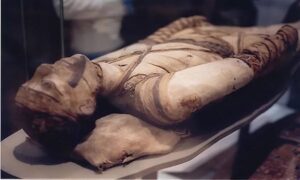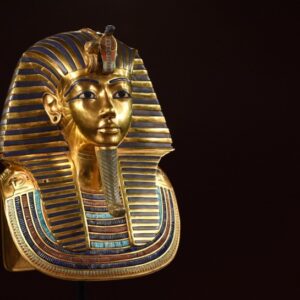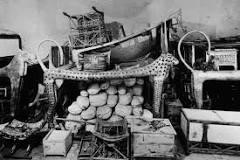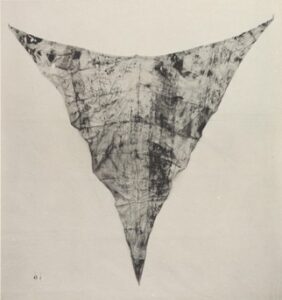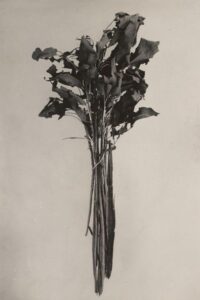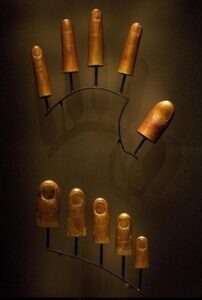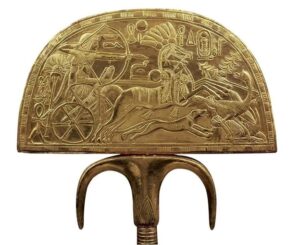King Tut’s long, long afterlife
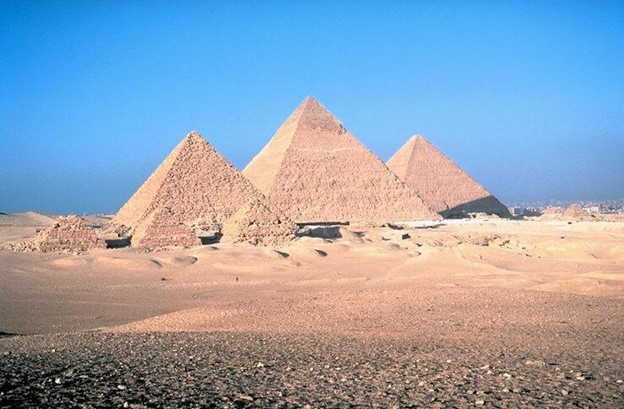
Fascination with the ancient Egyptians seems nigh inexhaustible. And why wouldn’t it be? There are all those pyramids, so pleasingly geometric against the stark and sandy landscape. In the pyramids, in those giant tombs, massive hoards of treasure. And at the very center of those hoards of gold and bejeweled items, mummies. How can one not be fascinated by mummies? They are corpses and corpses are tantalizing. But not just any corpses, corpses of kings and queens. Death, but death preserved for centuries and eons, for eternity.
Eternity in ancient Egypt usually meant, in reality, that these kings and queens were preserved just long enough for tomb raiders to plunder their tombs and sometimes make off with their corpses. Those mummies not lost to thievery mostly ended up in the glass cases of museums and historical displays. History has been and ever will be the playing field for irony.
he plundering of tombs and carrying-off of mummies has been going on for literally thousands of years. But there was an especially frenzied period of unearthing Egyptian tombs and other archeological riches during the 19th century and into the early 20th. It continues, if in a more muted fashion, to this day although the glamor of Egyptology has greatly faded. That’s because the history of European and American adventurers plundering the riches of northern Africa under the guise of archeology seems less heroic and more exploitative with each passing year. The call to return the various treasures of the ancient world to their places of origin also steadily increases. As do the calls to recognize the various Egyptian archeologists and laborers who often did much of the real discovering while the accolades went to the Europeans and Americans in charge of the digs. The story is depressing and shameful.
Nonetheless, it is hard to imagine that we will ever leave these old mummies alone. Given that there are more mummies out there (and there are definitely more mummies out there) and given that there are more hordes (and hordes there be), someone is going to try to dig them up. There has been so much digging for so long that there didn’t, by the late 19th century, seem to be any possibility of finding a truly untouched tomb anywhere near the so-called Valley of Kings.
And that’s why the discovery of the tomb of Tutankhamun was so extraordinary. The stuff of dreams, fantasies, dime-store novels. The kind of thing that never actually happens. But it did. A British archeologist (of sorts, he was never properly trained) named Howard Carter was working with the usual team of mostly unrecognized Egyptians. One of these workers more-or-less stumbled upon the more-or-less unmolested tomb of the Boy King, the 18th Dynasty ruler named Tutankhamun. It was 1922—interestingly the year that Egypt formally declared independence after forty years of direct English colonial rule. Tut had been reposing comfortably in his tomb for three thousand two hundred and twenty-three years, give or take.
There is an undeniably exciting moment in this story. The team of explorers had made their way to a door. Carter eked out a little hole into a sealed inner chamber with an iron rod. He peered through the hole with bated breath and remained silent for some time. The people behind him were dying with anticipation. They wanted to know what he was seeing. Was there anything in there? Carter waited until his eyes adjusted to the dim light. Finally, he uttered three famous words. “Yes,” he said, “wonderful things.”
(Actually, other persons present at the scene dispute this account. Carter might not have said this at all. I, for one, prefer to think he did. It’s a better story.)
Wonderful things indeed. The tomb of Tutankhamun contained some of the most splendiferous items ever unearthed from a forgotten hole in the ground. Tutankhamun’s second sarcophagus (there were three) was made completely of gold, the famous mask with its golden face and shining blue striped headdress.
Can we talk about the mask for a moment? It is, today, one of the most iconic art objects of the ancient world. The bling aspect of the mask, the solid gold and the precious jewels, are so bedazzling that it’s hard to stop and really look at the craftsmanship and the sensitivity in rendering Tutankahmun’s face. Experts tend to agree that this is one of the highpoints of the art of Egypt’s New Kingdom. Bling aside, why is the mask so mesmerizing? I think it is the tension between the hardness, the impenetrability of the materials (gold, quarts, obsidian, lapis lazuli, amazonite, glass, etc.) and the softness of the boy king’s features. There is something of the Mona Lisa’s enigmatic gaze here. Is he smiling? Is he wistful? I have never seen the mask in person, but one can look at pictures of the mask from every angle imaginable. The gaze alters significantly depending on what picture you pick. From some angles, he is the stern king: lawgiver, general, authority figure. From others a sadness creeps in. From still other angles, an almost sardonic grin. The fragility of a human being who lived and died thousands of years ago is in this mask. At the same time, something infinite, imperishable, absolute.
Which raises the question of what this mask was meant to be or do. Why did the ancient Egyptians make such wondrous tomb art? It turns out that it’s something of an anachronism to talk about ancient Egyptian ‘art’. In today’s world, we tend to experience art as something fundamentally aesthetic, something that has no purpose other than to be experienced as art. Ancient Egyptian art, like much of the world’s art that came before modernity, is tasked, by contrast, with a very specific purpose. In the case of tombs, the art is all part of the religious underpinning of ancient Egyptian society. This pertains especially to the mummy itself.
Ancient Egyptians had mastered the art of mummification. They’d developed procedures that preserved bodies so well one can still encounter those bodies, remarkably intact, to this day. And not just human bodies. The mummy of a lion, for instance, was recently found in the tomb of the woman who had been the wet nurse to Tutankhamun. Household pets were regularly mummified as well. The ancient Egyptians were geniuses at the art of mummification.
So, you could say that mummification was at the center of what ancient Egypt accomplished as a culture. And what the ancient Egyptians accomplished was a tremendously sophisticated and bafflingly complicated religion and cosmology, something like a grand view in which the various realms of existence were held and tied together by the stuff, including the human body itself, found in their tombs. The tombs were not just for pharaohs. Any schmoe could have a tomb and be mummified. The imperative in Egypt was essentially the following: Mummify everything! But this was especially true of pharaohs, of kings and queens, since they had a special relationship to the divine.
So, having some rudimentary understanding of why ancient Egyptians created their treasure-filled tombs is important if one wants to appreciate the art as anything more than piles of ancient bling.
This brings us back to Tut and his mask. It’s often said that the ancient Egyptians were interested, obsessed even, with eternal life. This is true, in a sense. But that doesn’t tell us much. All civilizations are likely obsessed with eternal life in one way or another. The interesting question is how eternity works. What role does the eternal play in a society? For the ancient Egyptians of Tutankahmun’s time, it was all a matter of the ka and the ba. And also sometimes the akh. I am certainly no expert on these matters, but even amongst the experts there seems to be a fair amount of confusion as to exactly what the ka, ba, and akh are and how they interrelate. The basics, however, are the following.
The ba, ka and akh are versions of what we might call the soul. The ba is the part of the soul most tied to the physical realm, to the actual body. At death, the ba detaches from the body, but is also able to reconnect to the body when it lies in the tomb. The ka, often represented as a bird, describes who the person was— their social standing, deeds, etc. The akh, finally, is something like the transfigured and eternal soul that lives in the Egyptian version of the afterlife amongst the gods.
What is most interesting about all of these bas, kas and akhs for us is that they reveal how complex were the ties between life and death in the worldview of the ancient Egyptians. The body of the pharaoh, a kind of living embodiment of the divine on earth, was important for the maintenance of these ties. That’s to say, the bodies of the dead hold the universe together. There was, for the ancient Egyptians, no infinite world without the finite world and vice versa. The soul needs the body, even after death. Or, to put it another way, physical, material reality and spiritual reality are but two sides of the same coin. The tomb of Tutankhuman, for instance, was filled with plenty of mundane things. There were hundreds of baskets filled with grains, figs, melons, loaves of bread. There was wine and beer in vessels throughout the tomb. There were musical instruments, including trumpets that, after the tomb was discovered, were played by contemporary musicians more than three thousand years after they had first been played.
Loaves of bread amidst piles of stuff in the tomb
Over one hundred and forty loincloths were found in the tomb of Tutankhamun. A small device for making fire was found. Bouquets of different kinds of plants and flowers were discovered, extremely fragile but still remarkably preserved over the millenia.
Harry Burton, Loincloth, 1923–25. Gelatin silver print. Department of Egyptian Art Archives (TAA 809)
Harry Burton, Plant bouquet, ca. 1923–24. Gelatin silver print. Department of Egyptian Art Archives (TAA 145)
This, along with plenty of fabulous items of silver and gold. I find myself especially delighted by a pair of golden sandals and, even more incredibly, toe and finger covers (stalls) found on the mummy of Tutankhamun. The stalls are pure gold and engraved with their own nails. They are basically golden toes and fingers to put over your normal toes and fingers.
Having golden toes seems like the very height of opulence. No doubt this is true. But it also further emphasizes the deeper theological and philosophical meaning of every item in Tutankhamun’s tomb. The golden flesh over the human flesh serves to highlight the double importance of Tutankhamun’s body. It is the body of the physical king. It is also the body of kingship itself. The tombs of ancient Egyptian pharaohs were generally the sites of cultic worship. Taking care of all of these physical objects, including the actual body of the deceased king, was a way to ensure stability of the cosmic order. Modern people have a tendency to think of the Egyptian obsession with the afterlife in personal terms. The ancient Egyptians wanted to live forever. But the actual importance of mummification and the preservation of material items in the tomb was more communal, societal. For the ancient Egyptians, the hereafter was very much present. The dead played a constant role in the continuation and maintenance of life in the here and now.
The ancient Egyptians had a word for this. They called it maat. It is another word difficult to translate exactly. Here’s how Egyptologist Salima Ikram defines it in her book Ancient Egypt: An Introduction:
The most important religious concept in ancient Egypt was that of maat. The foundation of the state, and indeed of the whole culture, rested upon this idea. … it might be explained as living a life that promotes and supports what is perceived as the divine order of things. It has been translated variously as ‘truth’, ‘order’, ‘rectitude’, or ‘balance/equilibrium’, and is the opposite of isfet, or ‘chaos’.
The mummy of Tutankhamun, and all the stuff he was surrounded by in that tomb, weren’t meant to go anywhere. They were meant to stay right there, forever. Sure, other aspects of Tutankhamun, like his ba and ka and akh had to migrate. But not in the sense of flying off into some other realm. The point even of ka and ba is that they come back into the tomb, they hover around and about, holding together the material and immaterial realms. Understood this way, the ancient Egyptians weren’t really obsessed with the afterlife. They were obsessed with life. And the only way to ensure the continuity and reproducibility of life was to make sure that death didn’t mess everything up. The giant pyramids of ancient Egypt are not launching pads to the hereafter; they are giant weights that keep divine order firmly anchored in the material realm.
That’s why all the gold and jewels in Tutankhamun’s tomb sits alongside loaves of bread and rudimentary loincloths. Everything, from the most mundane objects to the most refined, has a spiritual reality and, by that same token, all the spiritual objects are also just the things of this world. The unity of the material and spiritual is really what Tut’s tomb affirms.
Of course, we don’t have to have a deep understanding of the concept of maat in order to appreciate how exquisite and beautiful are the objects in Tutankhamun’s tomb. But I wonder sometimes if the objects do manage to impart some basic sense of maat, and of this complex relationship between the material and spiritual realms even to a contemporary audience. If nothing else, the exquisite stillness that seems to radiate from Tutankhamu’s face, which bears an expression Howard Carter described as “sad yet calm,” suggests deeper meanings behind all these shimmering objects.
Pulling at the thread of our wonder, it doesn’t take long to discover the basic outlines of the cosmology that gave rise to the incredible craftsmanship on display in Tutankhmaun’s tomb. The eminent Egyptologist Jan Assmann, for instance, translates an ancient Egyptian hymn in his book From Akhenaten to Moses.
The Bes with human heads…
He is (embodies) the bas of Amun-Re, lord of
Karnak, chief of Ipet-Sut
The ram with sublime face, who dwells in Thebes.
The great lion who generated by himself,
The great god of the beginning,
The ruler of lands and the king of gods,
The lord of heaven, earth, underworld, water, and
mountains.
Who conceals his name from the gods,
The giant of millions of cubits,
The strong … who fixed the sky on his head,
From whose nose the air comes forth,
In order to animate all noses,
Who rises as sun, in order to illuminate the earth,
From whose bodily excretions the Nile flows forth
in order to nourish every mouth
Assmann describes the theology behind this hymn as, “the idea of the world as an embodiment of a soul-like god and of God as a soul animating the world.” The “art” of ancient Egypt, if we can call it that, the slew of items found in Tutankhamun’s tomb, can only begin to be understood when they are seen as testimonial to the idea articulated in this hymn.
Let’s look at one last treasure from Tutankhamun’s tomb to drive home the point. The object is often referred to as the ‘ostrich hunt fan.’ It’s basically a long wooden stick with a wooden fan on the end of it. It is completely covered in gold. The fan is the sort of thing that servants would use to keep the pharaoh cool as he sat on his throne during a long day of issuing decrees and doing other pharaonic sorts of things. This fan is special in that it has an engraved (repoussé, actually, but let’s not get technical about it) scene on both sides. One side depicts Tutankhamun in the course of an ostrich hunt. On the other side, Tutankhamun is coming home, his hunt a success.
It’s been pointed out that these scenes, among others depicted on the objects in the tomb, belies the idea that Tutankhuman was especially weak or sickly, as has often been said of the boy king, mostly due to his early death and some trouble spots the experts have discovered on his skeleton and in his DNA. This is interesting enough, but only peripheral to the real fascination of the fan.
Hunt side of ostrich hunt fan
It is important that Tutankhamun is hunting ostriches in this scene. That’s because ostrich feathers (and Tut has gathered quite a bundle of them in the scene on the other side of the fan) are most associated with the goddess Ma’at, who is nothing but the personification of the concept maat. That’s to say, Tutankhamun is out in the world hunting for order and truth and justice. Helping him do this is a little cartoon-like guy in the very bottom right-hand side of the scene. Can you see him? He’s a little ankh (that famous Egyptian symbol that looks like a cross with a loop on top of it) with arms and legs. And he is holding a fan very much like the fan that the scene is engraved upon. It’s a bit of circular self-reference. The fan is telling us about itself. The fan is wielded by the ankh because the ankh is the fundamental symbol of life. Life moves. It blows, or at least wafts across the land. In this case, life is blowing itself upon Tutankhamun as he sets out after maat. The life of a particular being, in this case Tutankhamun, is tied to his ability to bring life to the whole community. By assuring order and justice, and goodness all around, Tutankhamun establishes the conditions by which the power of life can flow.
In the fan, we see how Tutankhamun’s individual and divine roles perfectly intersect. He is the human/divine in the service of both. And notice also how the material and immaterial are perfectly intertwined. The fan is a tool for blowing life-sustaining air onto the pharaoh, as it would on anyone else suffering in the brutal heat on any given day in Egypt. The fan is literally a stick for making the air move. So, it’s a symbol that actually is what it represents: life moving into and through bodies. And the living bodies that make up the whole society, in this case the society of the 18th dynasty, sustain one another in the rhythms and activities by which a society functions.
All of this is maat, a concept and a goddess and a real set of social relations enacted every day. That’s how it was possible for the ancient Egyptians to think of Tutankhamun as both a living and dead person but also a god and a possibility, a force that never really dies, that never stops acting, not in 1324 BCE, nor for all those millenia under the sand, nor even today as his tomb and treasures still exert an almost-miraculous power over everyone who has ever seen them in person, or read about them, or scrolled through endless pictures on the internet.
The king is dead, long live the king.

